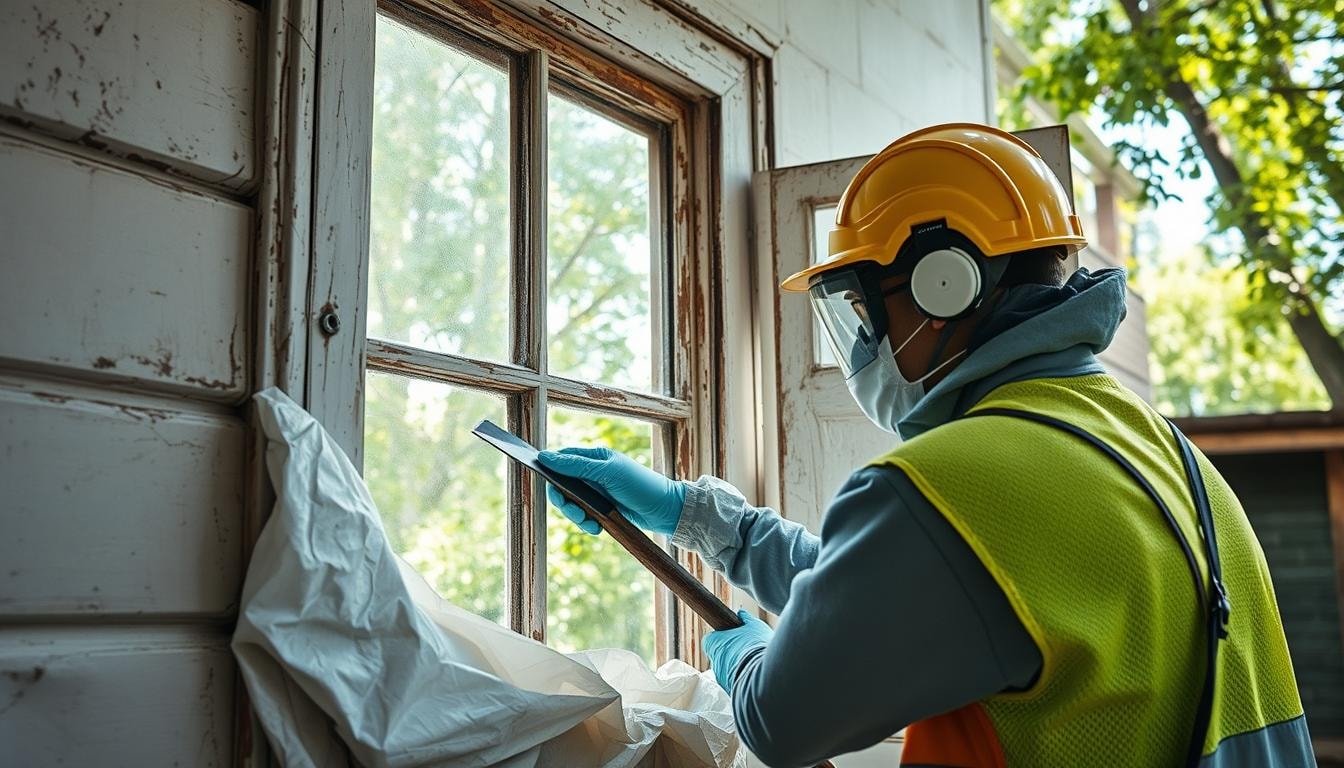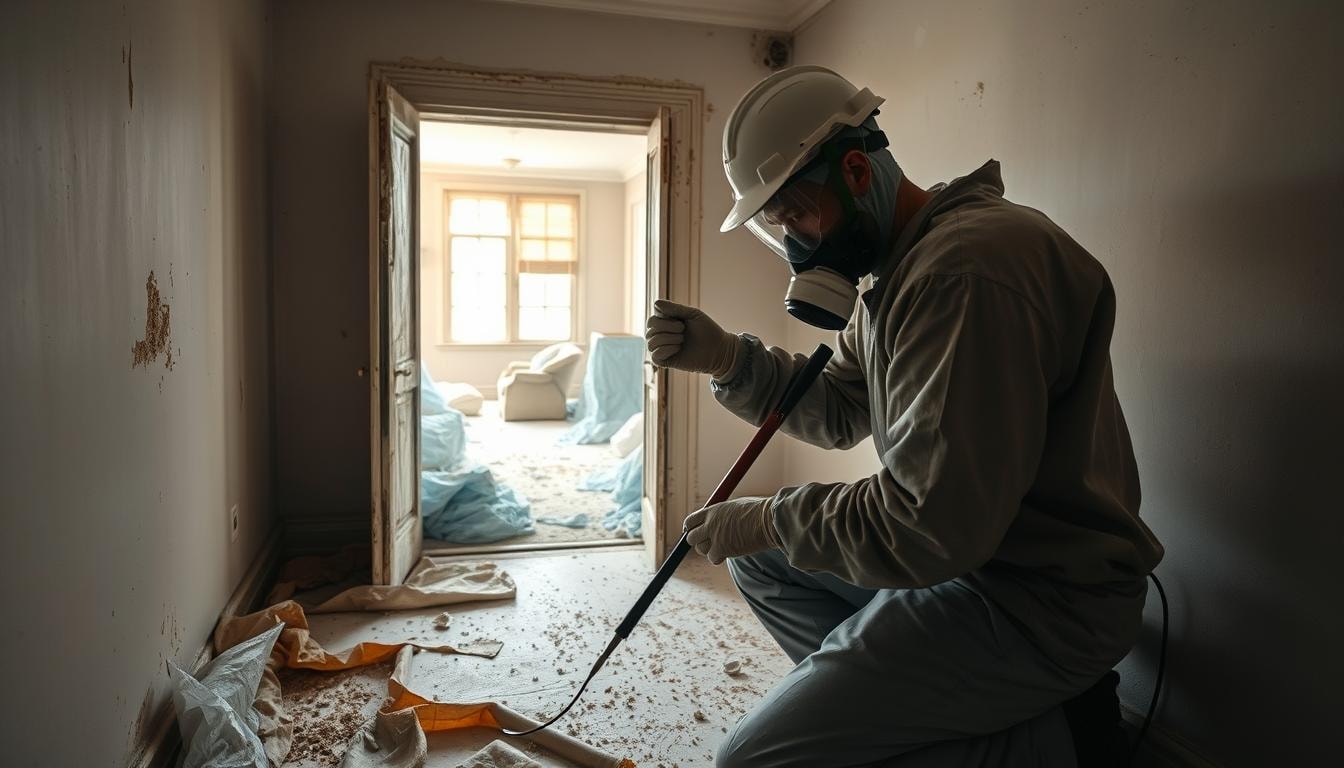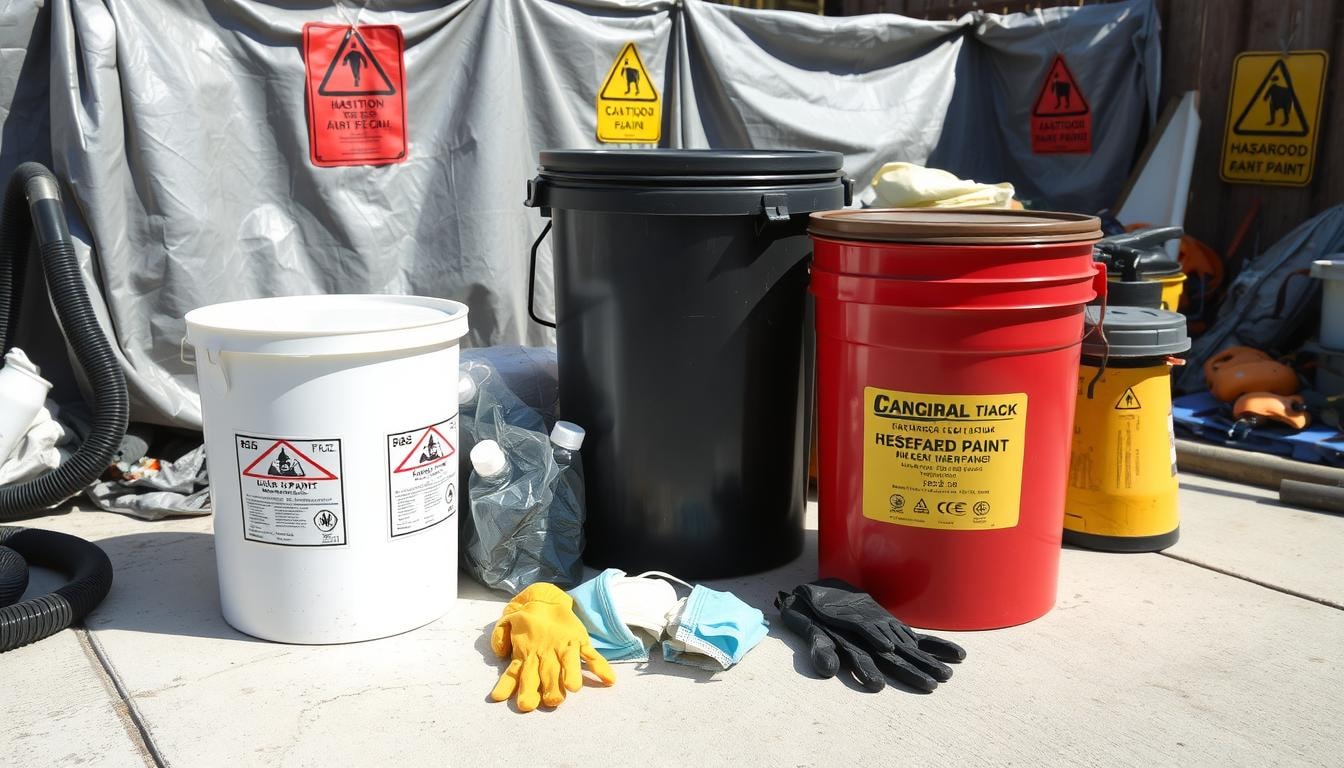Lead Paint Removal Near You
Can’t find what you are looking for?
How It Works
-
Answer a few questions about your home project.
-
Within seconds, get matched with top-rated local pros.
-
Compare quotes and choose the best pro for the job.
Lead Paint Removal In Your Area
Hiring a Lead Paint Removal Professional: What to Look For
Meta Description: When hiring a lead paint removal professional, look for certifications, experience, and safety protocols. Learn what to expect during the process and how to protect your home.

Lead-based paint in homes built before 1978 can be dangerous. It poses serious health risks, especially for children and pregnant women. Hiring a certified lead paint removal expert is crucial for safety.
A professional can safely handle the removal process. They have the right training, equipment, and experience. This ensures proper containment and disposal of hazardous waste.
Key Takeaways
-
01
Lead-based paint is a serious health hazard that can cause lead poisoning, especially in children and pregnant women.
-
02
Certified lead paint removal professionals have the training, equipment, and experience to safely handle the removal process.
-
03
Proper containment, safe removal techniques, and proper disposal of hazardous waste are essential to minimize the risks associated with lead dust and debris.
-
04
Hiring a certified lead professional is the best way to protect your family and your home during a lead paint removal project.
-
05
The costs of lead paint removal can vary widely, but it’s important to prioritize safety and hire a qualified professional.
The Dangers of Lead-Based Paint
Lead-based paint is a serious health threat. It’s especially dangerous for young children and pregnant women. Used in homes built before 1978, it can cause devastating health problems.
Lead paint exposure can harm blood cell production and calcium absorption. It can also damage the brain and kidneys. Lead paint chips, dust, and fumes are all harmful.
Health Hazards of Lead Exposure
Children are very vulnerable to lead poisoning. They can get it by eating or breathing in lead particles. Even small amounts can stunt a child’s growth and development.
Lead exposure can cause lower intelligence and learning disabilities in children. It can also lead to behavioral problems. A simple blood test can diagnose lead poisoning.
Adults can also suffer from lead paint exposure. It can cause high blood pressure, headaches, and dizziness. Other effects include reduced motor skills, fatigue, and memory loss.
Be aware of lead-based paints in older homes. Take precautions during renovations that may disturb these materials. Proper handling of lead paint is crucial to avoid fines and legal issues.
Preparing for Lead Paint Removal

Steps to Safely Remove Lead Paint
Proper preparation is key for lead paint removal. Seal off the work area to stop lead dust spread. Remove all furniture, rugs, and items from the space.
Workers must wear protective gear. This includes coveralls, goggles, gloves, and a NIOSH-approved respirator. These items guard against lead exposure.
Turn off the HVAC system to reduce dust. Keep the area wet during the process. Use safe removal techniques like wet sanding or scraping.
Enclosure, replacement, or encapsulation are other safe methods. Clean up thoroughly after the job. Dispose of lead-contaminated waste properly.
- Seal off the work area and remove all furniture, rugs, and household items.
- Wear personal protective equipment, including coveralls, goggles, gloves, and a NIOSH-approved respirator.
- Turn off the HVAC system and keep the area wet to reduce dust generation.
- Use safe removal methods like wet sanding, wet scraping, enclosure, replacement, or encapsulation.
- Thoroughly clean the area and properly dispose of lead-contaminated waste.
These steps help remove lead-based paint safely. They protect you and your family from lead exposure hazards. Follow them for effective and secure paint removal.
Safe Removal Techniques
Removing lead-based paint safely is vital to reduce lead dust and exposure risks. Wet sanding and scraping are best, as they keep paint damp and limit airborne dust. Use power tools only with HEPA-filtered attachments to catch lead particles.
Enclosure, replacement, and encapsulation are other good options for lead paint removal. These methods contain lead paint without full removal. This helps prevent the spread of lead-contaminated dust and debris.
Proper containment of the work area is essential for safety. Thorough cleanup procedures ensure all lead-contaminated materials are removed. These steps protect the health of everyone involved.
- Wet sanding and wet scraping to minimize lead dust
- Use of HEPA-filtered power tools to capture lead particles
- Enclosure, replacement, and encapsulation as alternative methods
- Proper containment of the work area to prevent lead dust spread
- Thorough cleanup procedures to ensure complete removal of lead-contaminated materials
Finding a Certified Lead Paint Removal Professional
Hiring a certified lead paint removal professional is crucial. In the U.S., lead professionals must have EPA certification for lead-related construction work. This includes inspectors, supervisors, workers, and project monitors.
Tips for Choosing a Certified Lead Professional
Certified professionals have training in lead-safe work practices. They know how to contain lead dust and minimize exposure risks. They’re also skilled in proper hazardous waste disposal.
When picking a lead professional, keep these points in mind:
- Ask to see their EPA certification to ensure they are lead-safe certified.
- Check their references and inquire about their experience with lead abatement projects.
- Discuss the specific safety precautions they will take during the project to minimize lead exposure.
Hiring a certified lead professional ensures safe work. It also guarantees compliance with the EPA’s lead renovation rule.
Lead Paint Removal Cost
Lead paint removal costs can vary widely. Homeowners typically pay between $2 to $15 per square foot for professional services. The overall project cost ranges from $1,445 to $5,412, with a national average of $3,428.
Several factors impact the final price. These include the size of the affected area, paint condition, and removal techniques required. The property’s location also plays a role in determining costs.
Larger projects with extensive containment and disposal procedures are usually more expensive. Homeowners may need to consider additional fees. These can include permits, contractor fees, and post-removal repairs or replacements.
Hiring a certified lead professional is crucial. They have the expertise and equipment to safely remove lead-based paint. This minimizes the risk of exposure during the removal process.
Factors Affecting Lead Paint Removal Cost
- Square Footage: The larger the affected area, the higher the overall cost. Removing lead paint from a 50 sq ft area can cost $400 to $850, while a 2,000 sq ft project may range from $8,000 to $34,000.
- Location: Lead paint removal costs can vary significantly based on the local market and cost of living. Projects in high-cost areas may be more expensive.
- Scope of Work: The specific techniques required, such as containment, disposal, and any necessary repairs, can impact the final price.
- Contractor Expertise: Hiring a certified lead professional with extensive experience may cost more, but ensures the job is done safely and effectively.
- Permits and Fees: Additional costs may include lead inspections, risk assessments, and disposal fees.
Lead paint removal is costly but vital for your family’s safety. Consult a certified lead professional to understand your project’s needs. They can provide specific requirements and costs for your situation.
The Importance of Proper Disposal

Proper disposal of lead-based paint debris is crucial for preventing health risks. Lead paint chips and dust must be carefully contained and disposed of. This prevents further environmental contamination and protects people’s health.
Lead paint is classified as hazardous waste. Improper disposal can result in hefty fines and penalties. The EPA has fined many contractors for not following lead-safe work practices.
Responsible homeowners and contractors must ensure safe disposal of lead-based paint materials. Following proper protocols is essential to avoid serious consequences for everyone involved.
- Double-bag all lead paint debris and dispose of it in limited quantities in the household trash, as per local regulations.
- Liquid waste, such as wash water, should never be dumped on the ground. Instead, filter it through a cloth before discharging it into the sanitary sewer.
- Mops, rags, and other cleaning materials used during the lead paint removal process must also be discarded properly to avoid spreading lead contamination.
Proper disposal of lead-based paint waste is a legal requirement. It’s also crucial for protecting community health. Homeowners and contractors should stay informed about current environmental regulations.
Working with certified lead paint removal professionals is important. They ensure safe and responsible disposal of all lead-related materials.
Why Hire a Certified Lead Paint Removal Professional
Certified lead paint removal experts are your best bet for safe home improvement. They’ve mastered lead-safe practices and use specialized equipment to minimize risks. These pros know EPA rules, containment methods, and proper disposal techniques.
DIY lead paint removal can endanger your family, especially kids and pregnant women. Certified professionals do the job right the first time. This approach is often more cost-effective than risky DIY attempts.
- Certified lead professionals have undergone specialized training in lead-safe practices
- They have the proper equipment and experience to minimize risks of lead dust and exposure
- They are knowledgeable about EPA regulations, containment, and disposal methods
- Attempting DIY lead paint removal can put your family at risk of lead poisoning
- Certified professionals can complete the job correctly the first time, which is more cost-effective
Certified lead pros are your safest choice for dealing with lead-based paint. Their expertise protects your family and ensures quality results. Trust these trained experts to handle your home’s lead paint removal needs.
Finding the Right Lead Paint Removal Pros with FindPros
Are you dealing with the presence of lead-based paint in your home? Conducting proper lead risk assessments and finding certified professionals to safely remove the hazardous paint is crucial. That’s where FindPros can help. Our platform connects you with top-rated local pros who are experienced in environmental protection agency-approved lead paint removal methods, such as using HEPA-filtered power tools, warm water, and other effective techniques to reduce exposure.
Simply answer a few questions about your home project, and we’ll match you with pros who can tackle the job, from paint stripping and surface preparation to installing new windows or replacing flaking, lead-affected areas. Our team will ensure you find the best pros that fit your needs and budget, so you can rid your property of lead hazards and enjoy a safer, healthier living space.
Conclusion
Lead-based paint removal is a crucial home improvement task. It requires a certified professional’s expertise. DIY removal can expose you and your family to dangerous lead poisoning.
Certified experts have the right training and equipment. They can safely contain the work area and remove lead paint. They also know how to dispose of hazardous waste properly.
Hiring a professional may cost more initially. However, it’s a vital investment in your home’s safety. Certified experts ensure the job is done correctly and minimize risks.
Lead-based paint and dust are major exposure sources in pre-1978 homes. The health consequences can be severe, including organ and brain damage.
Well-planned removal projects reduce unnecessary exposure during and after abatement. Encapsulation with flexible materials is a cost-effective option. Replacement is considered a better long-term solution.
Always hire a certified lead paint removal professional. They ensure the safety of your home and loved ones. This step is crucial for protecting your family’s health.
Frequently Asked Questions (Lead Paint Removal)
MOST POPULAR CITIES
Browse by State- Alameda
- Costa Mesa
- Laguna Beach
- Orange
- Alhambra
- Culver City
- Lancaster
- Oroville
- Anaheim
- Daly City
- Livermore
- Oxnard
- Antioch
- Davis
- Lodi
- Pacific Grove
- Arcadia
- Downey
- Lompoc
- Palm Springs
- Bakersfield
- El Centro
- Long Beach
- Palmdale
- Barstow
- El Cerrito
- Los Angeles
- Palo Alto
- Belmont
- El Monte
- Malibu
- Pasadena
- Berkeley
- Escondido
- Martinez
- Petaluma
- Beverly Hills
- Eureka
- Marysville
- Pomona
- Brea
- Fairfield
- Menlo Park
- Port Hueneme
- Buena Park
- Fontana
- Merced
- Rancho Cucamonga
- Burbank
- Fremont
- Modesto
- Red Bluff
- Calexico
- Fresno
- Monterey
- Redding
- Calistoga
- Fullerton
- Mountain View
- Redlands
- Carlsbad
- Garden Grove
- Napa
- Redondo Beach
- Carmel
- Glendale
- Needles
- Redwood City
- Chico
- Hayward
- Newport Beach
- Richmond
- Chula Vista
- Hollywood
- Norwalk
- Riverside
- Claremont
- Huntington Beach
- Novato
- Roseville
- Compton
- Indio
- Oakland
- Sacramento
- Concord
- Inglewood
- Oceanside
- Salinas
- Corona
- Irvine
- Ojai
- San Bernardino
- Coronado
- La Habra
- Ontario
- San Clemente